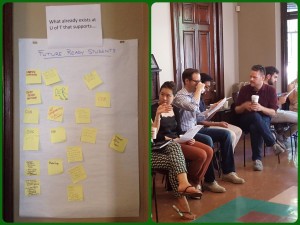 By Alexandra Rodney, Student Innovation Leader, Operations Team
By Alexandra Rodney, Student Innovation Leader, Operations Team
During the October Innovation Hours we asked students, staff and faculty to help us create a map of the University of Toronto ecosystem as it relates to our five domains of innovation.
Ecosystem mapping is an exercise designed to discover all of the resources an organization has at their disposal including people, programs, services, members and their relation to each other in both digital and physical realms. An ecosystems framework is borrowed from biologists who study the relationships between organizations and their environment, especially the impact that they have on each other.
At the Innovation Hour we aimed to learn more about the University of Toronto ecosystem by creating posters for each of the domains (Access for Every Student, Fostering Connectedness, Future-Ready Student, Integrated Learning and Whole Student Development) and asked attendees the following questions:
- What comes to mind when you hear…
- What already exists at U of T that supports…
Attendees wrote their ideas on post-it notes and added them to the posters. The goal was to brainstorm as many ideas, programs and services as possible in order to learn about how the U of T ecosystem is functioning.
During the Innovation Hours I saw attendees working independently at times, but discussing programs and services with others too. I also saw these U of T community members meeting new people and re-connecting with others they don’t necessarily interact with on a daily basis.
When reading the posters, aside from learning about a wide variety of programs and services at U of T related to the five domains, I was struck by the number of unfamiliar acronyms that I came across. CCP? FLC? FITA? ASC? I wondered how new students navigate these acronyms, not to mention trying to decipher how they could benefit from the variety of programs and services on offer.
The results of the ecosystem mapping have been organized into one ecosystem map (that looks more like a list at present). Next steps for the ecosystem map include drawing out connections between people, programs and services as well as evaluating strengths and gaps in the organization. Do you have anything to add to the ecosystem map? Are you interested in helping the Innovation Hub further develop the ecosystem map? We’d love to hear from you! Email innovationhub@utoronto.ca or comment on our Facebook thread to join the conversation!
The Innovation Hour is a great opportunity to come together with like-minded students, staff, faculty and community members who wish to create a more seamless student experience at University of Toronto. Each month’s Innovation Hours are organized around a different activity designed to encourage learning, collaboration and networking with U of T community members.
Please join us for our November Innovation Hours that will be hosted in the Baldwin Room, main floor of the Cumberland House (33 St. George St.).
Mark your calendar for the upcoming Innovation Hours:
- Thursday November 10th from 10:00am – 11:00am
- Tuesday November 15th from 9:00am – 10:00am
See you there!

0 comments on “Ecosystem Mapping: October Innovation Hours Recap”